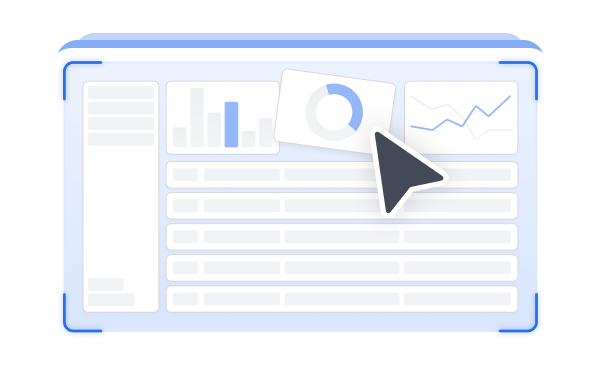In today’s fast-paced oil and gas industry, particularly in the midstream sector, operational excellence depends on timely, data-driven decisions. Whether it’s monitoring flows, managing nominations, or optimizing plant performance, having real-time visibility into operations is crucial.
The sheer volume and complexity of field data (ranging from pressure readings and production volumes to allocations and imbalances) can overwhelm even the most experienced teams. This is where data visualization in the oil and gas industry steps in, transforming raw data into intuitive, actionable intelligence.
At the heart of this transformation lies oil and gas control and data visualization software; a powerful blend of real-time monitoring, visual analytics, and integration with field systems.
As midstream teams strive for improved operational efficiency and regulatory compliance, real-time data visualization offers a clear path forward, enabling smarter decisions, reducing downtime, and enhancing collaboration across departments.
#The Power of Visual Analytics in Midstream Operations
Midstream operations involve a complex network of pipelines, processing plants, storage facilities, and distribution points. Every minute, vast amounts of data are generated from sensors, meters, and control systems. However, raw data alone is of limited value without the ability to interpret and act on it in real time.
Visual analytics bridges this gap by transforming numerical and textual data into dashboards, charts, and maps that highlight trends, anomalies, and key performance indicators (KPIs).
With energy solutions software like TIES (an integrated midstream energy software), operators can visualize the entire midstream ecosystem in one interface; turning isolated data points into meaningful stories.
For example, a dashboard tracking real-time imbalances between nominations and actual flows can alert operators instantly when a deviation occurs, allowing them to investigate and correct issues before they escalate.
#Real-Time Data in Oil and Gas: Enabling Actionable Insights
Traditional reporting models often relied on batch data that was collected and analysed after the fact. But in today’s dynamic operating environment, lagging indicators are no longer sufficient. Real-time data in oil and gas enables continuous monitoring and faster reaction times.
Consider the following real-time visualization examples in midstream operations:
Imbalance Tracking: Dashboards within TIES allow operators to visualize imbalances across pipelines and facilities. By comparing scheduled flows to actual measurements, teams can identify losses or discrepancies and address them proactively.
Plant Performance Analytics: Performance dashboards can display compressor efficiency, throughput volumes, downtime incidents, and energy usage in real time. This empowers operations teams to identify underperforming assets and make adjustments quickly.
Alert Dashboards: When anomalies such as pressure drops, temperature spikes, or equipment failures occur, alert dashboards provide instant visual cues. Notifications can be pushed to relevant personnel, reducing response time and minimizing the risk of costly downtime.
These examples illustrate how midstream oil digital solutions don’t just present data; they contextualize it, prioritize it, and deliver it to the right people at the right time.
For further insight, please refer to the following blog: “Data Visualisation in Oil and Gas: Seeing the Big Picture”.
#Integration with SCADA and IoT Systems
One of the key enablers of real-time visualization is the seamless integration with SCADA (Supervisory Control and Data Acquisition) systems and IoT (Internet of Things) devices. SCADA systems gather data from field equipment, while IoT sensors provide additional granularity and remote monitoring capabilities.
By integrating this data with midstream energy software platforms like TIES, operators can gain a 360-degree view of the field. For instance:
IoT-enabled flow meters can stream data directly into visual dashboards, providing up-to-the-minute readings on throughput.
SCADA alarms can trigger visual alerts, escalating events based on severity and sending them to relevant dashboards for immediate review.
Remote pressure and temperature sensors can help visualize potential bottlenecks or leaks across the network.
This level of integration ensures that decision-makers are not relying on outdated or siloed information. Instead, they benefit from a unified, real-time operating picture that drives faster and more confident decisions.
#Democratizing Data Across Departments
In many organizations, data silos create barriers to efficiency. Operations, engineering, accounting, and commercial teams often work with different tools and datasets, leading to inconsistencies and miscommunication.
Oil and gas control and data visualization software solves this problem by democratizing data across departments.
Operations Teams see real-time metrics on flows, pressures, and equipment status.
Accounting Teams have access to allocation data, nomination schedules, and audit trails.
Commercial Teams monitor capacity utilization, contractual obligations, and performance metrics.
By using a single source of truth, everyone in the organization stays aligned. This reduces manual reconciliation work, improves collaboration, and accelerates decision-making cycles.
#Enhancing Speed and Quality of Decision-Making
One of the most profound impacts of real-time data visualization is the acceleration of the decision-making process. Traditional decision-making often involved gathering reports, waiting for analysis, and manually cross-checking data across systems.
With energy solutions software that includes visualization tools:
Decision-makers can spot trends and anomalies instantly.
Operational issues can be escalated and addressed in minutes, not hours.
Long-term planning benefits from historical visual trends and predictive analytics.
In the fast-moving midstream sector, the ability to act decisively can be the difference between profitability and loss, uptime and downtime, safety and risk.
#Use Case: TIES Dashboards in Action
To bring the value of visualization to life, let’s examine how dashboards in TIES deliver operational visibility:
Flow and Nomination Dashboards
Operators can view real-time flow volumes alongside scheduled nominations, with clear visuals highlighting any mismatches. This helps teams quickly identify over- or under-deliveries and adjust operations accordingly.
Allocation Dashboards
Visual modules track how production is allocated across different wells, customers, or contracts. Accounting and commercial teams can monitor these allocations without needing to rely on complex spreadsheets.
Plant Performance Visualization
Compressor load, energy usage, and plant uptime are displayed on interactive dashboards, allowing engineers to benchmark performance across different sites and optimize configurations.
These capabilities illustrate the transformative power of real-time data visualization in midstream oil digital solutions.
For more details, please refer to the following blog: “Unlocking Plant Data: Why Internal Visibility Is Key for Midstream Efficiency”.
#Looking Ahead: The Future of Midstream Visualization
As the oil and gas industry continues its digital evolution, the role of data visualization in the oil and gas industry will only grow. With advancements in machine learning, predictive analytics, and AI-enhanced dashboards, visual tools will go beyond monitoring; they will begin to recommend actions, detect risks automatically, and simulate outcomes.
Moreover, as cloud adoption expands, midstream operators will increasingly access visual dashboards from any location, fostering more agile and distributed teams.
By embracing real-time visualization tools, midstream companies are not only improving operational performance; they’re building a culture of data-driven excellence.
#Conclusion
In a landscape defined by complexity and speed, real-time visualization is not just a technological upgrade; it’s a strategic imperative. From pipelines to processing plants, every decision counts, and those who can see clearly can act quickly.
Through platforms like TIES and other midstream energy software, the industry is witnessing a paradigm shift; from isolated data to integrated intelligence, from lagging indicators to real-time insights.
Whether it's reducing downtime, improving compliance, or boosting profitability, data visualization in the oil and gas industry is helping turn data into decisions and decisions into success.

Table of contents
- The Power of Visual Analytics in Midstream Operations
- Real-Time Data in Oil and Gas: Enabling Actionable Insights
- Integration with SCADA and IoT Systems
- Democratizing Data Across Departments
- Enhancing Speed and Quality of Decision-Making
- Use Case: TIES Dashboards in Action
- Looking Ahead: The Future of Midstream Visualization
- Conclusion



